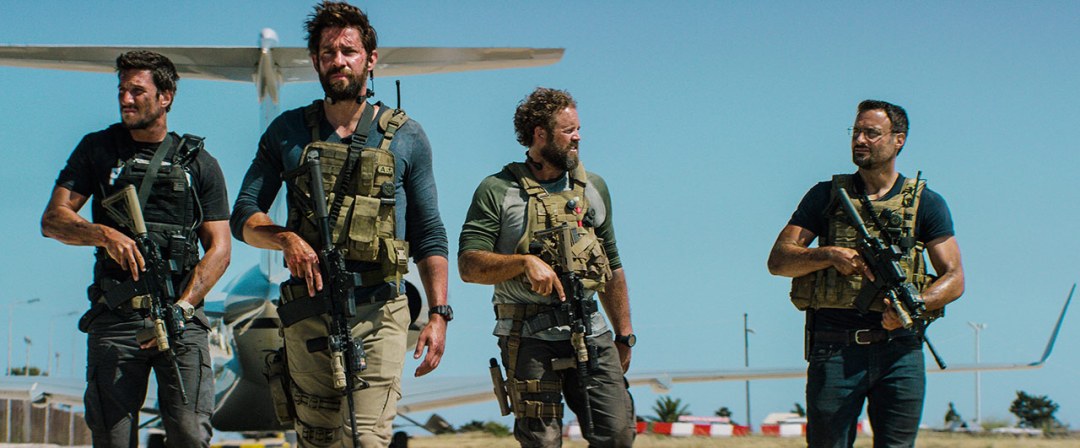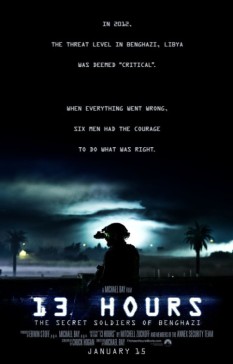 Michael Bay is a…divisive filmmaker. For as much money as his movies make, the “smart” critic crowd pretty much views him as the devil, the embodiment of everything that’s wrong with mass audience movies. While he occasionally tries something different like Pain & Gain (which I have not seen) that gets decent, if not overly-glowing, critical attention it winds up being pretty much ignored by the public, presumably driving the director to gravitate back to safe territory and keep signing on to direct Transformers sequels.
Michael Bay is a…divisive filmmaker. For as much money as his movies make, the “smart” critic crowd pretty much views him as the devil, the embodiment of everything that’s wrong with mass audience movies. While he occasionally tries something different like Pain & Gain (which I have not seen) that gets decent, if not overly-glowing, critical attention it winds up being pretty much ignored by the public, presumably driving the director to gravitate back to safe territory and keep signing on to direct Transformers sequels.
The director is back with something that’s not about big f***ing robots, 13 Hours. The movie tells the true story of the team of CIA contractors, many former SEALs who attempted to protect the U.S. consulate in Benghazi, Libya when it was attacked by terrorists and protesters. The team defied orders to not get involved and received no support from other American military assets and groups, leading to years of political wrangling and seemingly endless investigations. This story doesn’t get into all that, though, focusing solely on the actions of the soldiers as they tried on their own to protect the Americans under attack.
The Posters
The first poster lays out both the story and the one of the movie pretty clearly, in as unsubtle a way as you’d expect from a Michael Bay movie. We see a soldier running through a hellscape of fire and debris, multiple guns and ammunition for those guns hanging off his shoulders. Over that is copy – presented in a font meant to look like some sort of military teletype report – about the story and the six men “who had the courage to do what was right.” So it’s obvious this movie has a point of view, which is fine, and that it’s not going to beat around the bush in presenting that point of view.
Three posters were next released simultaneously, each one with a different visual theme. The first literally wraps a soldier in an American flag, emphasizing just how damn patriotic these guys were. The second shows a soldier on top of a building looking out into the night with his night-vision goggles on. The third shows Krazinski, looking ready for combat or having just come from combat and more than a little weary for the experience. All three feature the same “When everything went wrong…” copy, though the second expands on that slight. We’re meant here to really feel some emotional connection and stir of pride in the action of the soldiers whose stories are being depicted and, it’s hoped, associate the movie with that feeling and use it as a reason to go see it.
The Trailers
The first trailer – there was a red-band version as well – starts out by immediately signaling itself as a Michael Bay movie, with a golden shot of a kids playing in the light of dusk. We then two tough guys being pulled over in some sort of Middle Eastern country and pulling guns on the locals asking for their identification. It then shows the U.S. installation being attacked by protesters and the soldiers prepping to go, only to be told to stand down. It makes it look like they defy orders to go to the defense of the installation and we hear people talk about air support that was called but which never arrived and the stakes – 36 American lives – if the soldiers fail to act and succeed. In between all that we get title cards that set the location and other details about the story, including the fact that it’s a true story.
It’s not a bad trailer but just as I said with The Hateful Eight, it’s pretty easy to identify this as Bay’s movie from the tone of the visuals to the patriotic speeches to the fast, hand-held camera that’s on display. Aside from that it sells the movie certainly as a pulse-pounding action flick with lots of drama and lots of gunfights and other explosions. It steers clear of making any sort of comment about the actions anyone undertook that night except to say the CIA contractors who are at the heart of the story were clearly in the right as they tried to save lives, despite the actions of anyone else.
The second trailer – which also had a red-band version – skips some of the setup and immediately sets us in the situation of the diplomatic compound being under attack and the contractors going out to help them. Since it skips a lot of the story setup it focuses a lot more on the action, showing more of the military actions taken that night as the small group worked to protect that compound and save the people inside. It does everything it can to make this not just a visual experience but an emotional one as well as it shows just how hard these soldiers worked and what they were prepared to sacrifice to do their duty.
Aside from featuring a different collection of footage this version pretty much hits the same beats as the first and is really just a variation on a theme. The marketing team obviously found a tone they liked and so created this second trailer to match the first in many ways.
Online and Social
The official website for the film opens by playing the red-band version of the second trailer in a pop-up, so if you want to watch that again you can.
Scroll down on the page and you’re taken into a map of Benghazi and given a couple key facts about the city. If you click the Explore button you can pull up even more information, including population and other data points. This is a nice bit of background on the location of the story and the kind of feature I like to see when we’re dealing with historical stories.
In fact as you continue to scroll down the page you get more information on the real places and people in the movie, including the CIA Annex the contractors were based out of, brief bios of the real people whose story is being told. Those bios also include a GIF from the movie that you’re prompted to share on Twitter or other social networks.

The last few sections here are devoted to the sequence of events leading up to the soldiers coming to the aid of the diplomatic compound.
Going back to the top of the page there’s a menu that opens up to let you explore a few sections that contain more traditional marketing material. So “Videos” has just the same trailer that was on the front page (yellow card for inaccurate use of plural), “Gallery” has about a dozen stills and behind-the-scenes shots and “Story” has a brief plot synopsis.
The movie also had active profiles on Facebook, Twitter and Instagram where news stories, marketing assets, photos and other media were shared.
Advertising and Cross-Promotions
Based on the sheer number of TV spots created there was a massive amount of advertising done there. Different spots played up different aspects of the story, with some focusing more on the action and others playing up the emotional components, but almost all contained a few key scenes from the trailers like the “We’re the only help they have” shot and others. Tonally they’re very similar to the trailers and show off the big explosions and more that will appeal to many in the audience.
I’m sure there was also plenty of online and outdoor advertising done, especially on key industry and sites and in major markets, respectively.
Media and Publicity
A decent amount of the early press would focus on how Krazinski had bulked up a la Chris Pratt for his role as a career military man in the movie.
There was also plenty of press like this story that focused on how the material was translated from a book into a movie as well as the political turmoil that is envelops everything related to Benghazi. How the film walked the line between making an impact and not being overtly political continued to be a central focus of Bay’s interviews and other press around the movie.

Back to the first point, Krasinski would also spend a good amount of time on the press circuit talking about how this is such a departure for him to take a buffed-out action role when he’s primarily known for being the adorkable romantic comedy character. On a less obnoxious note, he also talked about the challenges of telling the story of a true man (his character’s name is changed, though) and wanting to do justice to that story and the actions of the team that night.
Overall
Well you certainly can’t accuse the campaign of not having a consistent look and feel to it. Everything here, from the posters to the website to the trailers and TV spots are covered in shrapnel, sweat and ‘Murica. Everything is deep blue and bright orange, with sparks flying around it and features the brow of an American patriot staring off into the distance as he contemplates his own mortality in the face of doing what’s right, whether that’s what’s allowed or not. The marketing, like the movie it’s selling, is earnest af.
As I said above, the campaign sells a movie that is 89% watching sweaty men carry around machine guns and choose to make the right decision. If I were going to guess – and I will – I’d say the marketing oversells the explosions and other action elements by more than a bit to make it seem like a non-stop adrenaline rush when I’m guessing there are plenty of dramatic elements as well. I’m not saying Bay is likely to slow the action down considerably, but there have to be pauses between some of the action, at least in the beginning, that aren’t really shown here in order to sell the film as a cacophony of action. We’ll see.
Want to get Movie Marketing Madness via email? Sign up here. Then connect with MMM on Twitter and Facebook.



